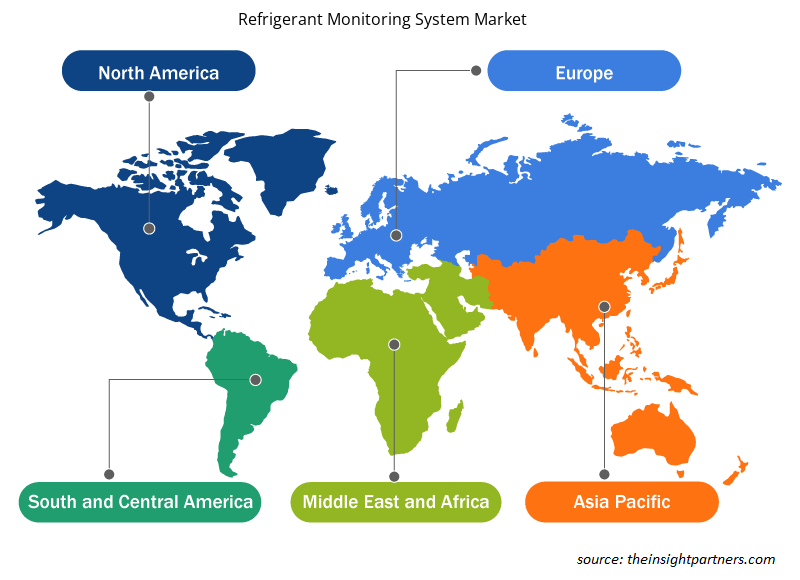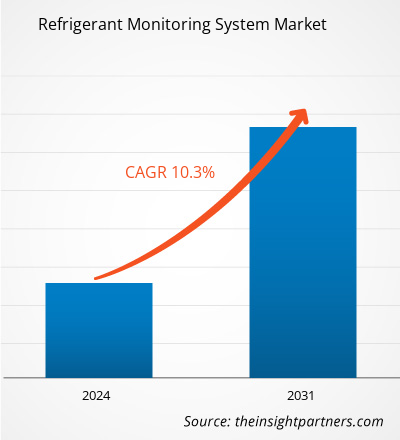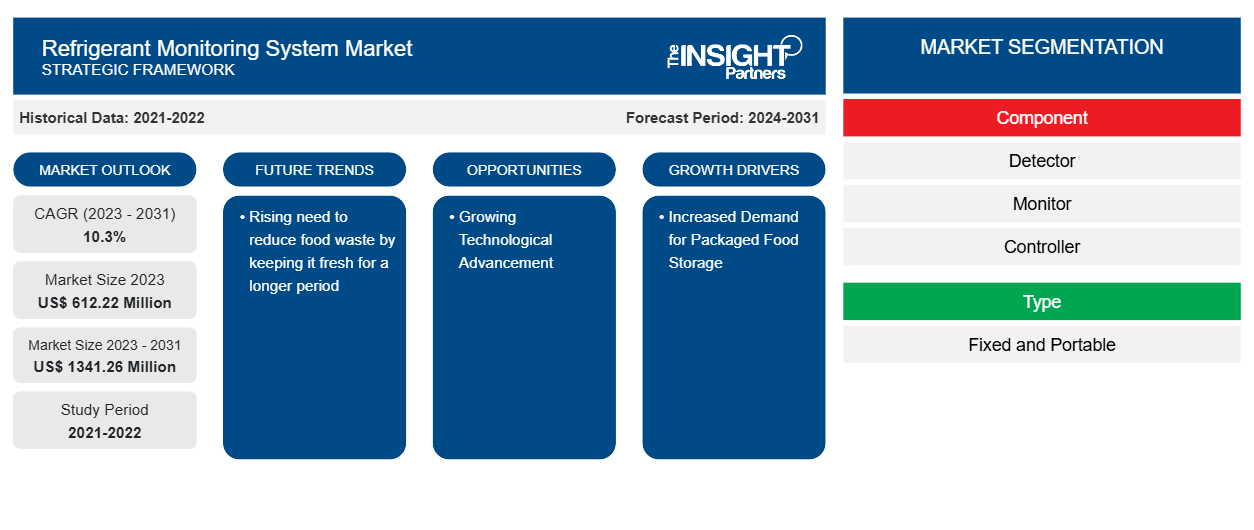Der Markt für Kältemittelüberwachungssysteme soll von 612,22 Millionen US-Dollar im Jahr 2023 auf 1.341,26 Millionen US-Dollar im Jahr 2031 anwachsen. Der Markt soll zwischen 2023 und 2031 eine durchschnittliche jährliche Wachstumsrate (CAGR) von 10,3 % verzeichnen. Die Notwendigkeit, Lebensmittelabfälle durch längere Frischhaltung zu reduzieren, wird wahrscheinlich weiterhin ein wichtiger Markttrend für Kältemittelüberwachungssysteme bleiben.
Marktanalyse für Kältemittelüberwachungssysteme
Die wachsende Zahl von Supermärkten und Schnellrestaurants weltweit ist einer der Hauptfaktoren, die das Wachstum des Marktes für Kältemittelüberwachungssysteme vorantreiben. Darüber hinaus treibt der Bedarf an Bio-Lebensmitteln aufgrund veränderter Konsumgewohnheiten das Wachstum des Marktes für Kältemittelüberwachungssysteme voran. Darüber hinaus wird erwartet, dass die interaktiven Benachrichtigungs- und Fernsteuerungsfunktionen von Kältesystemen das Wachstum des Marktes im Prognosezeitraum ankurbeln werden. Darüber hinaus schaffen laufende technologische Fortschritte im Bereich der Kältemittelüberwachungssysteme eine Chance für das Wachstum des Marktes für Kältemittelüberwachungssysteme in den kommenden Jahren.
Marktübersicht für Kältemittelüberwachungssysteme
Ein Kältemittelüberwachungssystem dient zur Überwachung der Raumluft auf Kältemittellecks. Dieses System wird für verschiedene Kühlanwendungen eingesetzt, darunter Kühlräume, Gefrierräume, Maschinenräume und mehr. Darüber hinaus können diese Systeme Alarme auslösen und Gebäudelüftungssysteme ansteuern und können in Gebäudeautomationssysteme integriert werden.
Passen Sie diesen Bericht Ihren Anforderungen an
Sie erhalten kostenlose Anpassungen an jedem Bericht, einschließlich Teilen dieses Berichts oder einer Analyse auf Länderebene, eines Excel-Datenpakets sowie tolle Angebote und Rabatte für Start-ups und Universitäten.
-
Holen Sie sich die wichtigsten Markttrends aus diesem Bericht.Dieses KOSTENLOSE Beispiel umfasst eine Datenanalyse von Markttrends bis hin zu Schätzungen und Prognosen.
Markttreiber und Chancen für Kältemittelüberwachungssysteme
Erhöhte Nachfrage nach verpackter Lebensmittellagerung
Da Berufstätige mit mehr Zeitdruck konfrontiert sind und Fertiggerichte immer häufiger erhältlich sind, steigt die Nachfrage nach verpackten Lebensmitteln. Darüber hinaus bieten verpackte Lebensmittel unter anderem verbesserte physische Sicherheit, Barriereschutz, Ansammlungsschutz, Werbung, umfassende Informationen zu den Inhaltsstoffen, Sicherheit und Eignung, was die weltweite Nachfrage weiter steigert. Da die meisten Kunden zudem variable Arbeitszeiten haben, steigt die Nachfrage nach verpackten oder verzehrfertigen Waren aufgrund von Zeitbeschränkungen. Daher treibt der Anstieg der Nachfrage nach verpackten Lebensmitteln das Wachstum des Marktes für Kältemittelüberwachungssysteme voran.
Wachsender technologischer Fortschritt
Die Marktteilnehmer arbeiten kontinuierlich an der Integration fortschrittlicher Technologien in das Kältemittelüberwachungssystem. Verschiedene Unternehmen arbeiten an der Integration fortschrittlicher IoT- Sensoren , die die Temperatur überwachen und Echtzeitbenachrichtigungen liefern, wenn die Temperatur in künstlichen Kühlsystemen schwankt. Darüber hinaus spart diese Lösung Zeit und Geld, indem sie die Energiekosten der Geräte senkt, die Leistung verbessert und den Kundenwert erhöht. Daher können solche technologischen Fortschritte im Kältemittelüberwachungssystem im Prognosezeitraum eine Chance für Marktwachstum schaffen.IoT forecasted period.
Segmentierungsanalyse des Marktberichts zum Kältemittelüberwachungssystem
Wichtige Segmente, die zur Ableitung der Marktanalyse für Kältemittelüberwachungssysteme beigetragen haben, sind Komponente, Typ und Anwendung.
- Basierend auf den Komponenten ist der Markt für Kältemittelüberwachungssysteme in Detektoren, Monitore, Controller und andere unterteilt. Das Controller-Segment hatte im Jahr 2023 einen größeren Marktanteil.
- Nach Typ ist der Markt in fest und tragbar unterteilt. Das feste Segment hatte im Jahr 2023 den größten Marktanteil.
- Nach Anwendung ist der Markt in gewerblich und industriell unterteilt. Das Industriesegment hielt im Jahr 2023 den größten Marktanteil.
Marktanteilsanalyse für Kältemittelüberwachungssysteme nach Geografie
Der geografische Umfang des Marktberichts zum Kältemittelüberwachungssystem ist hauptsächlich in fünf Regionen unterteilt: Nordamerika, Asien-Pazifik, Europa, Naher Osten und Afrika sowie Südamerika/Süd- und Mittelamerika.
In Bezug auf den Umsatz hatte Nordamerika den größten Marktanteil bei Kältemittelüberwachungssystemen. Der Markt in dieser Region ist in die USA, Kanada und Mexiko unterteilt. Die Nachfrage nach frischen Bio-Lebensmitteln und -Gemüse steigt in der Region aufgrund der raschen Urbanisierung und der zunehmenden Akzeptanz eines gesunden Ernährungsstils. Darüber hinaus erhöhen Krankheiten wie Diabetes, Fettleibigkeit und Bluthochdruck die Nachfrage nach Bio-Lebensmitteln weiter. Darüber hinaus hat die COVID-19-Pandemie die Vorlieben der Verbraucher in Richtung einer gesunden Ernährung verschoben. Laut der Organic Trade Association betrug der Verbrauch von verpackten Bio-Lebensmitteln in den USA im Jahr 2022 mehr als 22,2 Milliarden US-Dollar, was einer Wachstumsrate von 5 % im Vergleich zu 2021 entspricht. Darüber hinaus treibt die steigende Nachfrage nach Tiefkühlkost wie Fleisch, Meeresfrüchten, Eiscreme und anderen den Bedarf an Kältemittelüberwachungssystemen in der Region voran und treibt das Wachstum des Marktes für Kältemittelüberwachungssysteme weiter voran.
Regionale Einblicke in den Markt für Kältemittelüberwachungssysteme
Die regionalen Trends und Faktoren, die den Markt für Kältemittelüberwachungssysteme während des gesamten Prognosezeitraums beeinflussen, wurden von den Analysten von Insight Partners ausführlich erläutert. In diesem Abschnitt werden auch die Marktsegmente und die Geografie von Kältemittelüberwachungssystemen in Nordamerika, Europa, im asiatisch-pazifischen Raum, im Nahen Osten und Afrika sowie in Süd- und Mittelamerika erörtert.

- Erhalten Sie regionale Daten zum Markt für Kältemittelüberwachungssysteme
Umfang des Marktberichts zum Kältemittelüberwachungssystem
| Berichtsattribut | Details |
|---|---|
| Marktgröße im Jahr 2023 | 612,22 Millionen US-Dollar |
| Marktgröße bis 2031 | 1341,26 Millionen US-Dollar |
| Globale CAGR (2023 - 2031) | 10,3 % |
| Historische Daten | 2021-2022 |
| Prognosezeitraum | 2024–2031 |
| Abgedeckte Segmente |
Nach Komponente
|
| Abgedeckte Regionen und Länder |
Nordamerika
|
| Marktführer und wichtige Unternehmensprofile |
|
Dichte der Marktteilnehmer für Kältemittelüberwachungssysteme: Auswirkungen auf die Geschäftsdynamik verstehen
Der Markt für Kältemittelüberwachungssysteme wächst rasant, angetrieben durch die steigende Nachfrage der Endnutzer aufgrund von Faktoren wie sich entwickelnden Verbraucherpräferenzen, technologischen Fortschritten und einem größeren Bewusstsein für die Vorteile des Produkts. Mit steigender Nachfrage erweitern Unternehmen ihr Angebot, entwickeln Innovationen, um die Bedürfnisse der Verbraucher zu erfüllen, und nutzen neue Trends, was das Marktwachstum weiter ankurbelt.
Die Marktteilnehmerdichte bezieht sich auf die Verteilung von Firmen oder Unternehmen, die in einem bestimmten Markt oder einer bestimmten Branche tätig sind. Sie gibt an, wie viele Wettbewerber (Marktteilnehmer) in einem bestimmten Marktraum im Verhältnis zu seiner Größe oder seinem gesamten Marktwert präsent sind.
Die wichtigsten auf dem Markt für Kältemittelüberwachungssysteme tätigen Unternehmen sind:
- Air-Met Wissenschaftlich
- AquaGas Pty Ltd
- Bacharach, Inc
- Emerson Electric Co
- Genesis International
- Honeywell International
Haftungsausschluss : Die oben aufgeführten Unternehmen sind nicht in einer bestimmten Reihenfolge aufgeführt.

- Überblick über die wichtigsten Akteure auf dem Markt für Kältemittelüberwachungssysteme
Marktnachrichten und aktuelle Entwicklungen zum Kältemittelüberwachungssystem
Der Markt für Kältemittelüberwachungssysteme wird durch die Erfassung qualitativer und quantitativer Daten nach Primär- und Sekundärforschung bewertet, die wichtige Unternehmensveröffentlichungen, Verbandsdaten und Datenbanken umfasst. Im Folgenden finden Sie eine Liste der Entwicklungen auf dem Markt für Sprach- und Sprechstörungen und Strategien:
- Sensata Technologies gab die Markteinführung des Sensata ResonixTM RGD-Sensors bekannt, des ersten Leckerkennungssensors mit UL-Zertifizierung für mehrere A2L-Kältemittelgase, die in Heizungs-, Lüftungs- und Klimaanlagen (HVAC) verwendet werden. Die neuen Leckerkennungssensoren unterstützen HVAC-Hersteller bei der Umstellung auf Kältemittel mit geringerer Auswirkung auf die globale Erwärmung. (Quelle: Sensata Technologies, Pressemitteilung, 2023)
- Daikin hat die Einführung einer neuen, intelligenten Funktion zur Erkennung von Kälteanlagenlecks angekündigt, die Kühlanlagen und Anlagenbenutzer bei der Sicherheitsverwaltung und der Einhaltung der F-Gas-Vorschriften unterstützt. Die Technologie hinter der neuen Funktion basiert auf einem einzigartigen neuen Softwarealgorithmus, der von Daikin entwickelt wurde und historische Daten verwendet, um im Falle eines potenziellen Lecks Alarm zu schlagen und die Häufigkeit des Auftretens im Zeitverlauf zu melden, sodass Benutzer entscheiden können, ob Maßnahmen erforderlich sind. Der neue Algorithmus erkennt sogar langsame Gaslecks über einen erweiterten Lastbereich, beginnend bei 33 % der Gerätelast im Vergleich zu 50 % bei anderen Anwendungen auf dem Markt, und greift dabei auf Daten von einem Monat bis zu 12 Monaten zuvor zurück. (Quelle: Daikin, Pressemitteilung, 2021)
Marktbericht zum Kältemittelüberwachungssystem – Umfang und Ergebnisse
Der Bericht „Marktgröße und Prognose für Kältemittelüberwachungssysteme (2021–2031)“ bietet eine detaillierte Analyse des Marktes, die die folgenden Bereiche abdeckt:
- Marktgröße und Prognose auf globaler, regionaler und Länderebene für alle wichtigen Marktsegmente, die im Rahmen des Projekts abgedeckt sind
- Marktdynamik wie Treiber, Beschränkungen und wichtige Chancen
- Wichtige Zukunftstrends
- Detaillierte PEST/Porters Five Forces- und SWOT-Analyse
- Globale und regionale Marktanalyse mit wichtigen Markttrends, wichtigen Akteuren, Vorschriften und aktuellen Marktentwicklungen
- Branchenlandschaft und Wettbewerbsanalyse, einschließlich Marktkonzentration, Heatmap-Analyse, prominenten Akteuren und aktuellen Entwicklungen
- Detaillierte Firmenprofile
- Historische Analyse (2 Jahre), Basisjahr, Prognose (7 Jahre) mit CAGR
- PEST- und SWOT-Analyse
- Marktgröße Wert/Volumen – Global, Regional, Land
- Branchen- und Wettbewerbslandschaft
- Excel-Datensatz
Aktuelle Berichte
Erfahrungsberichte
Grund zum Kauf
- Fundierte Entscheidungsfindung
- Marktdynamik verstehen
- Wettbewerbsanalyse
- Kundeneinblicke
- Marktprognosen
- Risikominimierung
- Strategische Planung
- Investitionsbegründung
- Identifizierung neuer Märkte
- Verbesserung von Marketingstrategien
- Steigerung der Betriebseffizienz
- Anpassung an regulatorische Trends























 Kostenlose Probe anfordern für - Markt für Kältemittelüberwachungssysteme
Kostenlose Probe anfordern für - Markt für Kältemittelüberwachungssysteme